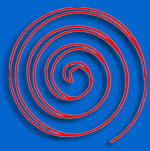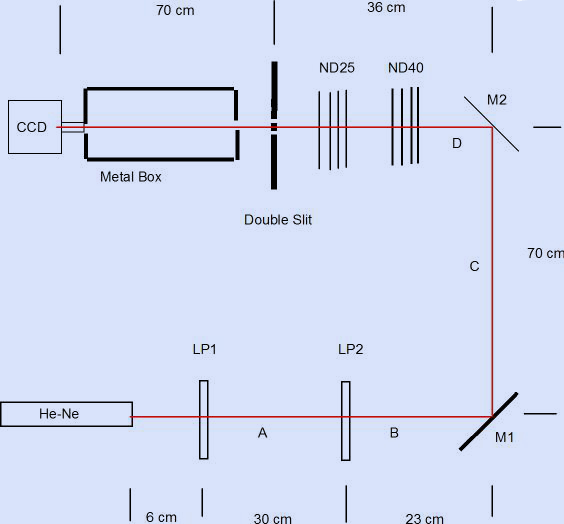
Quantum Measurement
Measurement
Statistics & Uncertainty Estimations
Heisenberg's Uncertainty Principle
- Fourier
Transform
- Aperture & Frequency
- Heisenberg Uncertainty Principle
- Questions
Relativity Theory & Causality
Spin, Polarization, and Mixed States
Bell's Inequality
Photon Double-Slit Experiment
Jeff Shrensel & Seyffie Maleki
Summer 2003
Introduction
It is an experimental fact that light is made of quantized photons. The energy of an individual photon is a product of Planck's constant with the photon's frequency value. So, if we sufficiently reduce the intensity of a light source, we could (in the absence of photon bunching) perform experiments with a few photons at one instant of time.
Our photon double-slit experiment is a simple example of "few photon at a time" case. In this experiment we attenuated the light intensity directed at a double-slit to the point that for each capture frame of our detector only about 12 photons made it through the slits. Using these data we created a movie that shows that although individual single frames just show a random distribution of photons, cumulative frames produce the familiar interference pattern that one expects from a light wave passing through a double-slit apparatus.
To see the movie of our data click on: Double-Slit Movie. Please note that this is real data and not a simulation!
Details of the experiment
Apparatus: we used a 3.0 mW Uniphase He-Ne laser, Coherent Field Master gs power meter, linear polarizers, mirrors, and ND-filters. Our detector was an image enhanced CCD camera system (PentaMax; Gen IV), Ropper Scientific (Princeton Instruments). Our movie is made of 30 captured frames, each with a capture duration of 1 ms. The first frame in the movie is the same as the first captured data frame, the second frame in the movie is the sum of the first and the second data frames, and so on. So, the last frame is the commutative data of 30 frames.

In the above sketch M1 and M2 are mirrors, LP1 and LP2 are linear polarizers and the CCD is the detector system. The purpose of the metal box is to both shield the camera from background light and to reduce the stray back reflected light from the camera entrance surface.
Before placing the neutral density filters (4 of ND 25 and 4 of ND 40) the laser intensity was measured at points A though D. The laser power at point D was measured to be 37 +- 7 nW. Both the double-slit slide and the box reduce light intensity as well. The effect of these were determined by measuring the intensities "before & after":
Slit-Filter reduction factor = 595 nW/ 1.18 mW = 5 x 10-4
Total (8) ND reduction factor = 238 nW/ 1.18 mW = 2 x 10-4
Final intensity at the camera = 37 nW x 10 -7 = 37 x 10-15 W
Then we calculate 12 photons reach the detector in one frame capture period (1 ms). Our detector has a 512x512 array, each of its pixels is 15x15 micro-meter in size.
